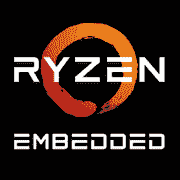AMD Ryzen Embedded R2312

AMD Ryzen Embedded R2312: Compact Power for Niche Tasks
March 2025
1. Key Specifications: Architecture and Performance
Architecture and Process Technology
The AMD Ryzen Embedded R2312 processor is based on the Zen+ microarchitecture (codename Picasso) and is manufactured using a 12nm process technology. This solution is aimed at embedded systems and compact PCs, where energy efficiency and stability are key factors. Despite the "age" of the architecture, Zen+ remains relevant due to its optimization for low power consumption (TDP of 15W) and support for modern interfaces.
Cores, Threads, and Cache
- 2 Cores / 4 Threads: Suitable for light multitasking scenarios (e.g., office applications + browser).
- L3 Cache 4 MB: Accelerates the processing of frequently used data, which is critical for embedded systems with limited memory bandwidth.
- Radeon Vega 3 (192 SP): Integrated graphics capable of basic gaming and 4K H.265 decoding.
Performance
According to Geekbench 6 tests:
- Single-Core: 959 — Comparable to Intel Core i3-10100T (2020), but lower than modern budget CPUs (e.g., Ryzen 3 7300U: ~1200).
- Multi-Core: 1706 — Weaker than 4-core counterparts but sufficient for background tasks (video surveillance, terminals).
Key Features
- Embedded Optimization: Support for long life cycles (up to 10 years), extended temperature range (-40°C to +105°C).
- Fanless Configurations: With a TDP of 15W, passive cooling systems are possible.
2. Compatible Motherboards
Socket and Chipsets
The processor uses the FP5 socket (BGA version), which means integration into Mini-ITX or NUC format boards. Motherboards with AMD Promontory BGA chipsets are compatible with the R2312, for example:
- ASRock IMB-R2312: Price ~$200–250. Supports HDMI 2.0, USB 3.2 Gen2, 2x Gigabit Ethernet.
- Advantech AIMB-222: ~$280. Focused on industrial applications: moisture and vibration protection.
Selection Considerations
- Interfaces: Look for boards with DisplayPort/HDMI 2.0 for 4K@60Hz.
- Expandability: M.2 for NVMe drives, PCIe x4 for additional controllers (e.g., Wi-Fi 6).
3. Supported Memory
Types and Frequency
The R2312 works with DDR4-2400/2666 MHz in dual-channel mode. The maximum capacity is 32 GB (2x16 GB). DDR5 is not supported, which limits upgrades but reduces the overall system cost.
Recommendations
- Optimal option: 2 modules of 8 GB (e.g., Kingston ValueRAM KVR26N19S6/8) — ~$40 for a set.
- For data storage systems: 16 GB DDR4-2666 + NVMe SSD (e.g., WD Red SN700 500 GB — ~$60).
4. Power Supply Units
Power Calculation
With a TDP of 15W and no discrete graphics, a 150–200W power supply is sufficient. Examples:
- Be Quiet! SFX Power 3 200W: ~$55. Silent, 80+ Bronze efficiency.
- FSP FlexGURU 150W: ~$45. Compact Flex-ATX format.
Tips
- For passive cooling, choose a PSU with a zero fan mode (e.g., Seasonic PRIME Fanless).
- Avoid cheap, noname PSUs: the risk of voltage spikes is critical for embedded systems.
5. Pros and Cons
Advantages
- Energy Efficiency: Ideal for 24/7 operation (e.g., digital signage).
- Vega 3 Graphics: Can handle Dota 2 at low settings (720p, 40–50 FPS) or 4K video.
- Long-Term Support: Software update guarantee until 2030.
Disadvantages
- 2 Cores: Multi-threaded tasks (rendering, streaming) will be a bottleneck.
- Price: ~$130 for the CPU — more expensive than comparable Intel Celeron (e.g., N5105 — ~$90).
6. Use Cases
- Office PCs: Document work, Zoom conferences, web browsing.
- Media Centers: Connection to TV via HDMI 2.0, 4K streaming.
- Industrial Systems: Machine control, IoT gateways.
- Light Gaming: Indie games (Hollow Knight, Stardew Valley) or retro console emulators.
Practical Example
In a smart home project, the R2312 was used as a hub for managing sensors and displaying information on a screen. Power consumption was 8W at idle, 13W under load.
7. Comparison with Competitors
- Intel Celeron N5105 (Jasper Lake): 4 cores, TDP 10W, UHD Graphics. Cheaper (~$90) but weaker in single-threaded tasks (Geekbench 6 Single: ~750).
- Rockchip RK3588 (ARM): 8 Cortex-A76/A55 cores, 8K HDMI. Better for multimedia but has challenges with x86 software compatibility.
- AMD Ryzen Embedded V1605B: 4 cores / 8 threads, Vega 8. More powerful, but TDP of 25W and priced from $200.
Conclusion: The R2312 strikes a balance between x86 compatibility and price but falls short in multi-threading performance.
8. Assembly Tips
1. Case: Mini-ITX (e.g., InWin Chopin Pro — ~$100) or industrial chassis (AAEON GENE-APL5).
2. Cooling: Passive heatsink NoFan CR-80EH (~$30) or Noctua NH-L9a cooler.
3. Storage: Ensure SSD (SATA or NVMe) — HDD will slow down the system.
4. Network: Add Wi-Fi 6 via M.2 card (Intel AX210 — ~$25).
9. Final Conclusion
AMD Ryzen Embedded R2312 is a specialized solution for:
- Compact Office PCs with low power consumption.
- Industrial and IoT Systems that require stability.
- Media Centers where 4K graphics are important.
Do not choose this processor if you need multi-threaded performance or an upgrade to DDR5. However, it remains one of the best in its class for niche tasks due to its reliability and optimization for long-term use.
Prices are current as of March 2025. They are for new devices in retail networks.
Basic
CPU Specifications
Memory Specifications
GPU Specifications
Benchmarks
Compared to Other CPU
Share in social media
Or Link To Us
<a href="https://cputronic.com/index.php/cpu/amd-ryzen-embedded-r2312" target="_blank">AMD Ryzen Embedded R2312</a>